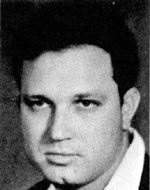Mor (Winkler), Meir (“Meirke”)
Son of Shmuel and Doba. He was born on April 29, 1940 in Tel Aviv. When he was two and a half years old, the family moved to Haifa. Meir attended elementary school and soon became prominent among his classmates. He was a youthful youth movement and at the age of 15. He was a member of the “Hashomer Hatzair” youth movement and therefore claimed that another academic in the city was not a mission and that his mission was personal fulfillment and exit. – The high school school went on to join the Nahal Brigade in October 1957, together with its members in Kibbutz Nachshon and found its place there. He joined the paratroopers with his comrades. He read a lot and took an interest in everything around him. He was also interested in art and theater. Together with his comrades in the nucleus, he embarked on advanced training and saw it as a duty that one should not shirk. Was connected to his home and worried about his mother and his letters. He tried to reassure her that the conditions were difficult, but Meir had the extraordinary ability to adjust to them and see them with good humor and humor. He loved his camera and she accompanied him on all his walks across the country. Everything he saw in nature was immortalized in his photographs. When he left the Nachshon farm in 1965, he moved to Jerusalem and loved to spend his walks in the streets of the city, observing the city between the walls. He called the city immediately to come and loved her with all his soul. Since arriving in Jerusalem, he has worked his way through his own efforts until he finally arrived at the Ministry of Health to prepare an international conference for psychiatrists that was to be held in June 1967. At that time he prepared to continue his studies. His concern for his son was great and he visited him two or three times a week. Every spare moment he devoted to meeting him and being with him would add to the child, as he had given the father, great encouragement. From time to time he would go on reserve duty and even during the Six-Day War was in this framework. On the third day of her battles, he was 28 Iyar 5727 (7.6.1967), fell in a battle held on the Old City of Jerusalem the capital; It was when he tried under a barrage of shells to help stop the blood flow of one wounded man at the Rockefeller Museum; Then a shell hit him nearby. Being loved by his comrades-in-arms, because they saw him as the living spirit among the soldiers from the days of his regular service, his comrades-in-arms rushed to set up the spot immediately after his fall. Booklet published in memory and commemorating his name. In the album “Jerusalem of Paratroopers” his name was immortalized by bringing his photograph. In the book “Marinas Gabro” of the Paratroopers Headquarters was devoted a page to his history and description of his last battle. In Gogli Esh, vol. 4, the library of the estate of the sons who fell in the Israeli army, was brought from his estate. On the eve of Yom HaAtzma’ut 5706, a photographic exhibition on the subject “Jerusalem” was held at Beit Agron in Jerusalem, and a first prize was awarded to him in his honor.
